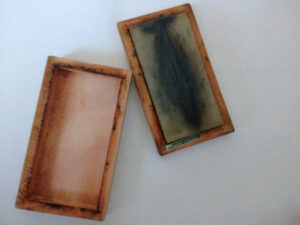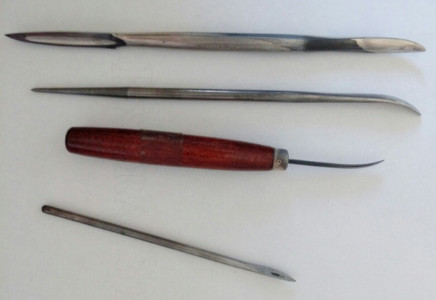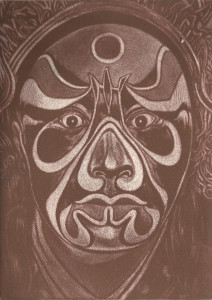An approach to engraving techniques
The black manner or mezzotinto
Among the different techniques of engraving, which is a procedure of printing, whether it be « hollow » (print, dry-point, etching and aquatintes) or « in relief » (xylography, linography, gerflex…), the black manner, or mezzotinto, is a special case.
If the support is still a metal plate, the manner of working is very different due to the small number of tools used and the way that the drawing is elaborated on the plate itself, for the engraver is guided by a quest for light.
In France, very few engravers use the black manner – ten at the most. This technique, invented in Germany in 1642 by a citizen of Hesse, Ludwig von Siegen, was developed especially in England in the following centuries. The Japanese also engrave using the black manner because it corresponds to a subtlety of detail which they seek.
The mezzotint rocker: btaining a totally velvet-smooth black
At the outset, the polished copper plate is covered with dots using a mezzotint rocker with a semi-circular, finely-toothed cutting edge which leaves a stippled line on the copper. Using a swinging movement, the engraver covers the copper with a closely knit network of lines. Then the operation is repeated perpendicularly and, finally, diagonally in the original directions until all smooth and intact places have been eliminated.
This work, carried out in numerous directions, gives a perfectly regular texture to the plate, which is nearly white and brilliant, on which the contour of the drawing can be drawn in pastel. This very slow operation, which must be done, moreover, in a very regular way, requires many hours of work. The deeper the work with the mezzotint rocker, the more intense the black will be at the inking. Stamps made in the black manner are recognizable by the total, velvet-smooth and incomparable black of the places worked on with the mezzotint rocker verified by the first inking before the following operation.
The mezzotint rocker wears out; it is thus necessary, in order to conserve the quality of the square-rolled screen, to sharpen it regularly, which slows down the work in the élaboration of this phase.


Working with the burnisher: bringing out the white and its values
In order to create the drawing, certain zones of the surface worked on with the mezzotint rocker are progressively lightened. The points then appear clearly. The more the latter are smoothed out, the more they will retain the ink. The operation is carried out with a burnisher used flatly or with a scraper (by working on the bevel of the tool) so as to avoid making a deep cut on the plate. In fact, the slightest hollow on a surface retains the ink. This process erases, more or less, according to the type of drawing desired, the initial work done with the steel rocker.
To obtain an absolute white, we return horizontally to the initial stage on the copper plate, which is polished again. Certain defective parts can be corrected by working on them again with the mezzotint rocker.
The work is done in the negative in difficult conditions; the difference in the brilliance of the copper indicates to the eye the different shades obtained, which are visible against the sunlight in the semi-obscurity of the studio. The use of the burnisher requires a certain physical strength of a very regular intensity along with a certain precision, almost as if one was sculpting the plate.

The material used in the work with the mezzotint rocker on copper remains fragile and wears out rapidly; thus, to preserve it intact, the engraver is advised to carry out only rare inking checks. As is the case for all engravings, the plate used in the definitive printings will then be covered with a layer of steel in order to maintain the fineness and quality of the first one. The copperplate printer carries out this operation. The plate can now be used as long as the new film laid down by electrolysis protects it. If the plate starts to wear out, a second steel-coating can be done, which can make it possible to make hundreds of copies from the same plate.
Strictly speaking, there are no successive trials in the black manner; at least, they do not present the same interest as in etching. The engraver, working with light, obtains surfaces which little by little form the model according to imperceptible, intentional gradations. Herein lies the interest of this technique based on the most highly successful mastery of drawing. One can say that the burnisher, when handled well, plays the role of a white pencil.
Traditionally, the inking is done in black. Due to the roughness of the points it is advisable to use a supple leather inking pad or a hard roller full of ink, because the work with the steel rocker at the surface will retain plenty of ink. Outside the zones of intact, work done with the steel rocker, the engraver wipes the plate with tarlatan. Finally, he wipes the surface lightly and repeatedly with the palm of his hand, which is then wiped each time on the fabric of the smock. The ink is thus redistributed in order to eliminate the excess. The whites are recovered with silk paper passed very delicately on the finger.
As with all other techniques, the prints require the use of a piece of paper which has been wet and then brushed before the passage of the press. The sheet turned over on the plate, whose bevels have been carefully wiped, will receive the inverted drawing after the printing. This paper, for the black manner, is called « ink lover« ; indeed, ink retention is thick on the paper-it can be felt by the finger and contributes to the colour intensity of all work well done by hand. Coloured inking requires much meticulousness since the coulored inks are placed together on the same plate-and replaced by others with the finger-unless there are several plates according to the colours, which requires a marking out each time.
As for myself, since 2004 I have been combining regular, gold, flat surfaces of great intensity (which corresponds to the backgound worked on by the steel rocker) with coloured surfaces, aware that the inking work must be carried out rapidly because gold dries faster than colour.
An engraving derives as much from Art in its creative spirit combined with a rigorous, fixed process as it does from craft, in all its gestures of a real trade to result in a careful, definitive and desired piece. On each sheet, the engraver writes with a lead pencil the number of the print as well as the total number of copies to be printed. Separate trials can constitute artists’ proofs or printers’ proofs. A copy will be given as a copyright to the National Library, Engraving Department.
Thus, an engraved print must include its number, title (optional), and the name of the artist, the hollowed surface of the plate and rather wide paper margins. It is always a unique piece.

